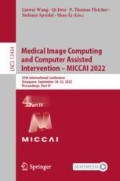Abstract
Localization of tube-shaped objects is an important topic in medical imaging. Previously it was mainly addressed via dense segmentation that may produce inconsistent results for long and narrow objects. In our work, we propose a point-based approach for explicit centerline segmentation that can be learned by fully-convolutional networks. We propose a new bi-directional encoding scheme that does not require any autoregressive blocks and is robust to various shapes and orientations of lines, being adaptive to the number of points in their centerlines. We present extensive evaluation of our approach on synthetic and real data (chest x-ray and coronary angiography) and show its advantage over the state-of-the-art segmentation models.
Access this chapter
Tax calculation will be finalised at checkout
Purchases are for personal use only
References
Ambrosini, P., Ruijters, D., Niessen, W.J., Moelker, A., van Walsum, T.: Fully automatic and real-time catheter segmentation in x-ray fluoroscopy. In: Descoteaux, M., et al. (eds.) MICCAI 2017. LNCS, vol. 10434, pp. 577–585. Springer, Cham (2017). https://doi.org/10.1007/978-3-319-66185-8_65
Chen, L.C., Zhu, Y., Papandreou, G., Schroff, F., Adam, H.: Encoder-decoder with atrous separable convolution for semantic image segmentation. In: Proceedings of the European conference on computer vision (ECCV), pp. 801–818 (2018)
Frid-Adar, M., Amer, R., Greenspan, H.: Endotracheal tube detection and segmentation in chest radiographs using synthetic data. In: Shen, D., Shen, D., et al. (eds.) MICCAI 2019. LNCS, vol. 11769, pp. 784–792. Springer, Cham (2019). https://doi.org/10.1007/978-3-030-32226-7_87
Pan, L.S., Li, C.W., Su, S.F., Tay, S.Y., Tran, Q.V., Chan, W.P.: Coronary artery segmentation under class imbalance using a u-net based architecture on computed tomography angiography images. Sci. Rep. 11(1), 1–7 (2021)
Peng, S., Jiang, W., Pi, H., Li, X., Bao, H., Zhou, X.: Deep snake for real-time instance segmentation. In: Proceedings of the IEEE Computer Society Conference on Computer Vision and Pattern Recognition, pp. 8530–8539 (2020). https://doi.org/10.1109/CVPR42600.2020.00856
Pothineni, N.V., et al.: Coronary artery injury related to catheter ablation of cardiac arrhythmias: a systematic review. J. Cardiovasc. Electrophysiol. 30(1), 92–101 (2019)
Sirazitdinov, I., Lenga, M., Baltruschat, I.M., Dylov, D.V., Saalbach, A.: Landmark constellation models for central venous catheter malposition detection. In: 2021 IEEE 18th International Symposium on Biomedical Imaging (ISBI), pp. 1132–1136. IEEE (2021)
Sirazitdinov, I., Schulz, H., Saalbach, A., Renisch, S., Dylov, D.V.: Tubular shape aware data generation for segmentation in medical imaging. Int. J. Comput. Assist. Radiol. Surg., 1–9 (2022)
Subramanian, V., Wang, H., Wu, J.T., Wong, K.C.L., Sharma, A., Syeda-Mahmood, T.: Automated detection and type classification of central venous catheters in chest x-rays. In: Shen, D., et al. (eds.) MICCAI 2019. LNCS, vol. 11769, pp. 522–530. Springer, Cham (2019). https://doi.org/10.1007/978-3-030-32226-7_58
Sun, K., et al.: High-resolution representations for labeling pixels and regions. arXiv preprint arXiv:1904.04514 (2019)
Tang, J.S., et al.: Clip, catheter and line position dataset. Sci. Data 8(1), 1–7 (2021)
Wei, F., Sun, X., Li, H., Wang, J., Lin, S.: Point-set anchors for object detection, instance segmentation and pose estimation. In: Vedaldi, A., Bischof, H., Brox, T., Frahm, J.-M. (eds.) ECCV 2020. LNCS, vol. 12355, pp. 527–544. Springer, Cham (2020). https://doi.org/10.1007/978-3-030-58607-2_31
Wood, B.J., et al.: Navigation with electromagnetic tracking for interventional radiology procedures: a feasibility study. J. Vasc. Intervent. Radiol. 16(4), 493–505 (2005)
Xie, E., et al.: PolarMask: Single shot instance segmentation with polar representation. In: Proceedings of the IEEE Computer Society Conference on Computer Vision and Pattern Recognition, vol. 1, pp. 12190–12199 (2020). https://doi.org/10.1109/CVPR42600.2020.01221
Yi, X., Adams, S., Babyn, P., Elnajmi, A.: Automatic catheter and tube detection in pediatric x-ray images using a scale-recurrent network and synthetic data. J. Digital Imaging 33(1), 181–190 (2020)
Yi, X., Adams, S.J., Henderson, R.D., Babyn, P.: Computer-aided assessment of catheters and tubes on radiographs: how good is artificial intelligence for assessment? Radiol. Artif. Intell. 2(1), e190082 (2020)
Zhou, Y.-J., et al.: Real-time guidewire segmentation and tracking in endovascular aneurysm repair. In: Gedeon, T., Wong, K.W., Lee, M. (eds.) ICONIP 2019. LNCS, vol. 11953, pp. 491–500. Springer, Cham (2019). https://doi.org/10.1007/978-3-030-36708-4_40
Zhou, Y.J., Xie, X.L., Hou, Z.G., Bian, G.B., Liu, S.Q., Zhou, X.H.: Frr-net: fast recurrent residual networks for real-time catheter segmentation and tracking in endovascular aneurysm repair. In: 2020 IEEE 17th International Symposium on Biomedical Imaging (ISBI), pp. 961–964. IEEE (2020)
Zhou, Z., Siddiquee, M.M.R., Tajbakhsh, N., Liang, J.: Unet++: redesigning skip connections to exploit multiscale features in image segmentation. IEEE Trans. Med. Imaging 39(6), 1856–1867 (2019)
Zolotarev, A.M., et al.: Optical mapping-validated machine learning improves atrial fibrillation driver detection by multi-electrode mapping. Circul. Arrhythmia Electrophysiol. 13(10), e008249 (2020)
Author information
Authors and Affiliations
Corresponding author
Editor information
Editors and Affiliations
1 Electronic supplementary material
Below is the link to the electronic supplementary material.
Rights and permissions
Copyright information
© 2022 The Author(s), under exclusive license to Springer Nature Switzerland AG
About this paper
Cite this paper
Sirazitdinov, I., Saalbach, A., Schulz, H., Dylov, D.V. (2022). Bi-directional Encoding for Explicit Centerline Segmentation by Fully-Convolutional Networks. In: Wang, L., Dou, Q., Fletcher, P.T., Speidel, S., Li, S. (eds) Medical Image Computing and Computer Assisted Intervention – MICCAI 2022. MICCAI 2022. Lecture Notes in Computer Science, vol 13434. Springer, Cham. https://doi.org/10.1007/978-3-031-16440-8_66
Download citation
DOI: https://doi.org/10.1007/978-3-031-16440-8_66
Published:
Publisher Name: Springer, Cham
Print ISBN: 978-3-031-16439-2
Online ISBN: 978-3-031-16440-8
eBook Packages: Computer ScienceComputer Science (R0)


